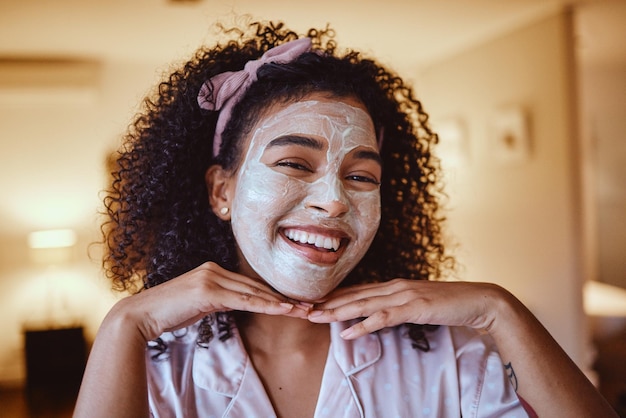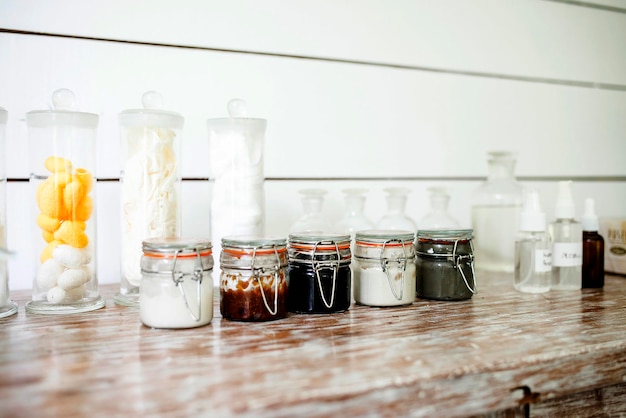DIY Beauty Revival: Safely Recreating Viral Skincare at Home

DIY beauty is back, fueled by viral skincare recipes online; this article explores how to recreate these trends at home safely, focusing on ingredient selection, hygiene, and understanding potential risks to achieve effective and personalized skincare.
The allure of crafting personalized skincare solutions has brought DIY beauty back into the spotlight, with viral recipes promising radiant results; however, navigating these trends safely is key to avoiding potential skin irritations or adverse reactions, ensuring a positive and effective experience.
Why DIY Beauty Is Trending Again
DIY beauty is not a new concept, but its resurgence can be attributed to a few key factors. People are seeking more control over the ingredients that come into contact with their skin and are looking for affordable alternatives to expensive commercial products. The ease of access to information and recipes online has also played a significant role in popularizing DIY beauty.
One of the primary drivers behind DIY beauty’s revival is the desire for transparency and natural ingredients. Many commercially available skincare products contain chemicals, preservatives, and synthetic fragrances that some people prefer to avoid. By making their own products, individuals can ensure that they are using only ingredients they trust.
Affordability and Customization
Another compelling reason to embrace DIY beauty is the cost savings. High-end skincare products often come with hefty price tags, while the ingredients needed for homemade versions are typically much more affordable. This allows individuals to experiment with different formulations and find what works best for their skin without breaking the bank.
Customization is also a major advantage. With DIY beauty, one can tailor recipes to suit specific skin concerns, such as dryness, acne, or sensitivity. This personalized approach ensures that the products being used are precisely what the skin needs, maximizing their effectiveness.
- Transparency: Knowing exactly what ingredients are in your skincare products provides peace of mind.
- Affordability: Save money by using inexpensive, readily available ingredients.
- Customization: Tailor recipes to address your individual skincare needs.
- Natural Ingredients: Avoid harsh chemicals, synthetic fragrances, and preservatives.
In conclusion, the renewed interest in DIY beauty is driven by the pursuit of natural, affordable, and personalized skincare solutions. The accessibility of information and the desire for transparency have empowered individuals to take control of their beauty routines, experimenting with homemade products to achieve their desired results.
Essential Safety Tips for DIY Skincare
Safety is paramount when venturing into DIY skincare. While the idea of crafting your own beauty products can be exciting, it’s crucial to adhere to guidelines to avoid potential adverse reactions or skin damage. Understanding the ingredients and following proper sanitation practices are key to a safe DIY experience.
One of the most critical aspects of safe DIY skincare is ingredient knowledge. Not all natural substances are beneficial for the skin, and some can even be harmful. It’s essential to research each ingredient thoroughly before incorporating it into a recipe. Pay close attention to recommended concentrations and potential allergens.
Sanitation and Hygiene
Maintaining a clean and sanitary environment is equally important. Bacteria and other contaminants can quickly spoil homemade skincare products, leading to infections or skin irritations. Always wash your hands thoroughly before starting, and sanitize all tools and containers with antibacterial soap or alcohol.
Proper storage is crucial for extending the shelf life of DIY skincare products. Store your creations in airtight containers in a cool, dark place to prevent degradation. Label each product with the date of creation to ensure that you’re not using anything that’s past its prime.

- Ingredient Knowledge: Research each ingredient thoroughly to understand its properties and potential risks.
- Sanitation: Maintain a clean workspace and sanitize all tools and containers.
- Storage: Store products in airtight containers in a cool, dark place.
- Patch Testing: Always perform a patch test before applying a new product to your face.
In conclusion, DIY skincare is a rewarding endeavor when approached with caution and a focus on safety. By understanding the ingredients, maintaining a clean environment, and following proper storage practices, you can create effective and personalized skincare products without compromising your skin’s health.
Understanding Viral Skincare Recipes: Fact vs. Fiction
The internet is flooded with viral skincare recipes, each promising miraculous results, sorting through these claims can be challenging, as not all viral recipes are created equal. Some may be based on sound scientific principles, while others may be nothing more than misinformation.
Begin by critically evaluating the source of the recipe. Is it coming from a reputable skincare expert, or is it simply being shared by someone without qualifications? Look for recipes backed by scientific evidence or endorsed by dermatologists to ensure their validity.
Common Myths and Misconceptions
Many viral skincare recipes promote ingredients that are either ineffective or potentially harmful. For example, lemon juice is often touted as a natural skin brightener and acne treatment, but its high acidity can disrupt the skin’s pH balance, leading to irritation and sun sensitivity. Similarly, baking soda is sometimes recommended as an exfoliant, but it can be overly abrasive and damage the skin’s protective barrier.
Another misconception is that all-natural ingredients are inherently safe. While natural ingredients can be beneficial, some can cause allergic reactions or sensitivities in certain individuals. Always perform a patch test before introducing a new ingredient to your skincare routine.
- Evaluate the Source: Ensure the recipe comes from a reputable and knowledgeable source.
- Beware of Harmful Ingredients: Avoid recipes that recommend lemon juice, baking soda, or other potentially irritating substances.
- Question Miraculous Claims: Be wary of recipes promising overnight results or unrealistic transformations.
- Patch Test Everything: Always test a new ingredient or recipe on a small area of skin before full application.
In summary, navigating the world of viral skincare recipes requires a discerning eye and a healthy dose of skepticism. By evaluating the source, avoiding harmful ingredients, and questioning unrealistic claims, you can separate fact from fiction and make informed decisions about what you put on your skin.
DIY Skincare Ingredients: What to Use and What to Avoid
The key to successful DIY skincare lies in choosing the right ingredients. While many natural substances offer incredible benefits for the skin, others can be detrimental. Knowing which ingredients to use and which to avoid is paramount to creating safe and effective homemade beauty products.
When selecting ingredients, prioritize those known for their gentle and nourishing properties: Aloe vera soothes and hydrates the skin, making it ideal for sun protection, honey is a natural humectant that helps retain moisture, while also offering antibacterial properties, oats have anti-inflammatory benefits and can relieve itching and irritation.
Beneficial Ingredients
Several studies suggest that these ingredients can be game changers for your skin. Look for sources that back these points up and avoid products that contradict these findings.
On the other hand, several ingredients should be avoided altogether. Lemon juice, as mentioned earlier, can cause irritation and sun sensitivity. Essential oils, while aromatic and potentially beneficial, should be used with caution. Always dilute essential oils properly and avoid applying them directly to the skin.

- Aloe Vera: Soothes and hydrates the skin, making it ideal for sunburn relief.
- Honey: Retains moisture and offers antibacterial properties.
- Oats: Have anti-inflammatory benefits and alleviate itching.
- Avoid Lemon Juice: Can disrupt the skin’s pH balance and cause irritation.
In conclusion, choosing the right ingredients is essential for safe and effective DIY skincare. By prioritizing gentle, nourishing ingredients and avoiding potentially irritating substances, you can create a personalized skincare routine that nurtures and protects your skin. It’s a good idea to research as much as you can before putting anything on your skin.
Step-by-step Guide to Recreating a Viral Skincare Recipe (Safely)
Recreating viral skincare recipes can be a fun and rewarding experience, but it’s crucial to approach the process with care and precision. A step-by-step approach is essential, from selecting the right recipe to measuring and mixing ingredients accurately.
Begin by choosing a recipe from a reliable source. Once you have your recipe, gather all the necessary tools and ingredients. Ensure that everything is clean and sanitary before you begin. Measure each ingredient accurately, using measuring spoons or a digital scale.
Mixing and Testing
Follow the recipe instructions carefully. Some recipes may require heating or blending ingredients, while others may involve a simple mixing process. Pay attention to any specific instructions or warnings. Once you’ve created your product, perform a patch test on a small area of skin. Wait 24 hours to see if any irritation or allergic reaction occurs before applying it to your face.
Once you’ve made sure that your skin can handle the ingredients and that the product is efficient, you can also tweak it a bit to match your expectations.
- Choose a Reliable Recipe: Start with a recipe from a trusted source.
- Gather Clean Tools and Ingredients: Ensure everything is clean and sanitary.
- Measure Accurately: Use measuring spoons or a digital scale.
- Patch Test: Wait 24 hours to see if any irritation occurs.
In conclusion, carefully following a step-by-step process can help you safely recreate viral skincare recipes. By starting with a reliable recipe, gathering clean tools and ingredients, and performing a patch test, you can minimize the risk of adverse reactions and enjoy the benefits of personalized DIY skincare.
Long-Term Benefits and Risks of DIY Beauty
While the DIY beauty trend offers numerous advantages, such as customization and cost savings, it’s essential to consider the long-term benefits and risks associated with homemade skincare. A balanced perspective is crucial for making informed decisions about your skincare routine.
One of the Long term benefits of DIY beauty is the ability to avoid harsh chemicals and synthetic ingredients that are common in commercial products. This can be particularly beneficial for people with sensitive skin or allergies. Additionally, DIY skincare encourages a deeper understanding of your skin’s needs and how different ingredients affect it.
Potential Drawbacks
However, there are also potential risks to consider. Homemade skincare products typically have a shorter shelf life than commercial products because they lack preservatives. This means they are more susceptible to bacterial contamination, which can lead to skin infections or irritations. Furthermore, accurately measuring ingredients and maintaining consistent formulations can be challenging; inconsistent results can lead to skin irritation or ineffective treatment.
Before trying anything, you should always consult with a specialist that can assess the overall efficiency of the homemade products you are trying to produce. Most of the time, you will be able to work with specific ingredients that may work wonders on your specific skin.
- Avoidance of Harsh Chemicals: Benefit for sensitive skin or allergies.
- Deeper Understanding of Skin Needs: DIY encourages a more personalized skincare routine.
- Shorter Shelf Life: Susceptible to bacterial contamination.
- Inconsistent Formulations: Can lead to skin irritation or ineffective treatment.
In conclusion, DIY beauty offers many advantages, but it’s crucial to weigh the long-term benefits against the potential risks. By understanding the limitations of homemade products, maintaining strict hygiene practices, and consulting with a dermatologist when necessary, you can enjoy the best of both worlds—personalized skincare that supports the health and vitality of your skin.
| Key Point | Brief Description |
|---|---|
| 🧼 Hygiene | Always sanitize tools and containers to prevent contamination. |
| 🧪 Ingredients | Research ingredients thoroughly before use. |
| ⚠️ Patch Test | Apply a small amount to test for reactions. |
| 📅 Shelf Life | Homemade products expire faster; label and date each creation. |
Frequently Asked Questions
▼
DIY skincare can be adapted for various skin types, but careful ingredient selection is essential. Those with sensitive skin should perform thorough patch tests and avoid harsh ingredients like lemon juice or strong essential oils.
▼
To extend the life of DIY skincare, store products in airtight, dark-colored containers away from direct sunlight and heat. Adding natural preservatives like vitamin E oil can also help prevent oxidation and bacterial growth.
▼
Common mistakes include using overly abrasive ingredients, neglecting proper sanitation, and following unverified recipes. Always research ingredients, disinfect tools and containers, and consult reputable sources for safe and effective formulations.
▼
While some DIY recipes may provide relief for mild symptoms, they are not a substitute for professional medical treatment. Consulting a dermatologist and using prescribed medications are essential for managing serious skin conditions.
▼
Certain ingredients, such as undiluted essential oils, lemon juice, and harsh exfoliants like baking soda, should be avoided in DIY skincare. These can cause irritation, burns, and long-term damage to the skin’s protective barrier.
Conclusion
In conclusion, the resurgence of DIY beauty offers exciting opportunities for personalized skincare, but safety should always be the top priority. By understanding the potential benefits and risks, researching ingredients thoroughly, and following strict hygiene practices, you can recreate viral skincare recipes at home safely and effectively. Embrace the trend responsibly to enhance your skin’s health and radiance.
